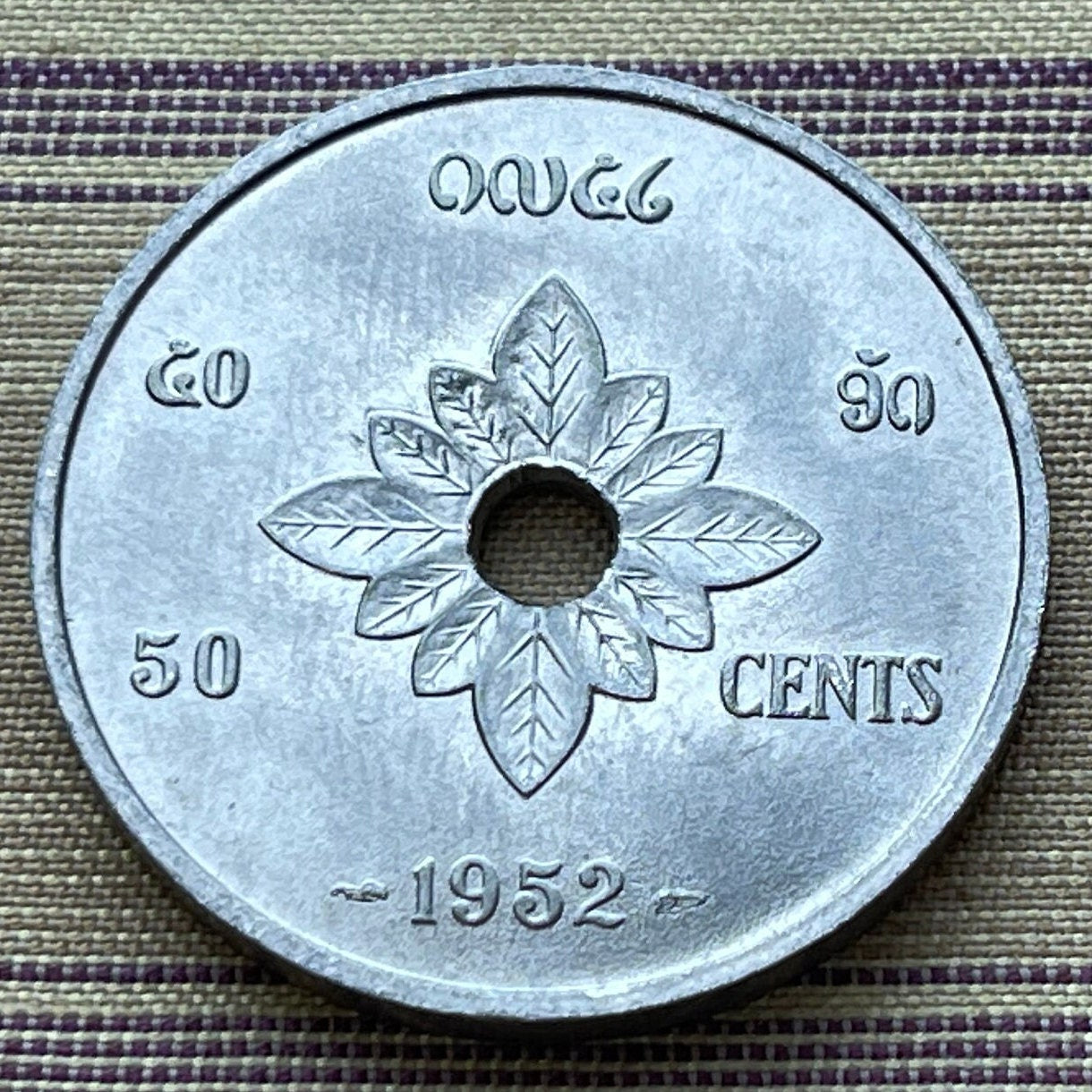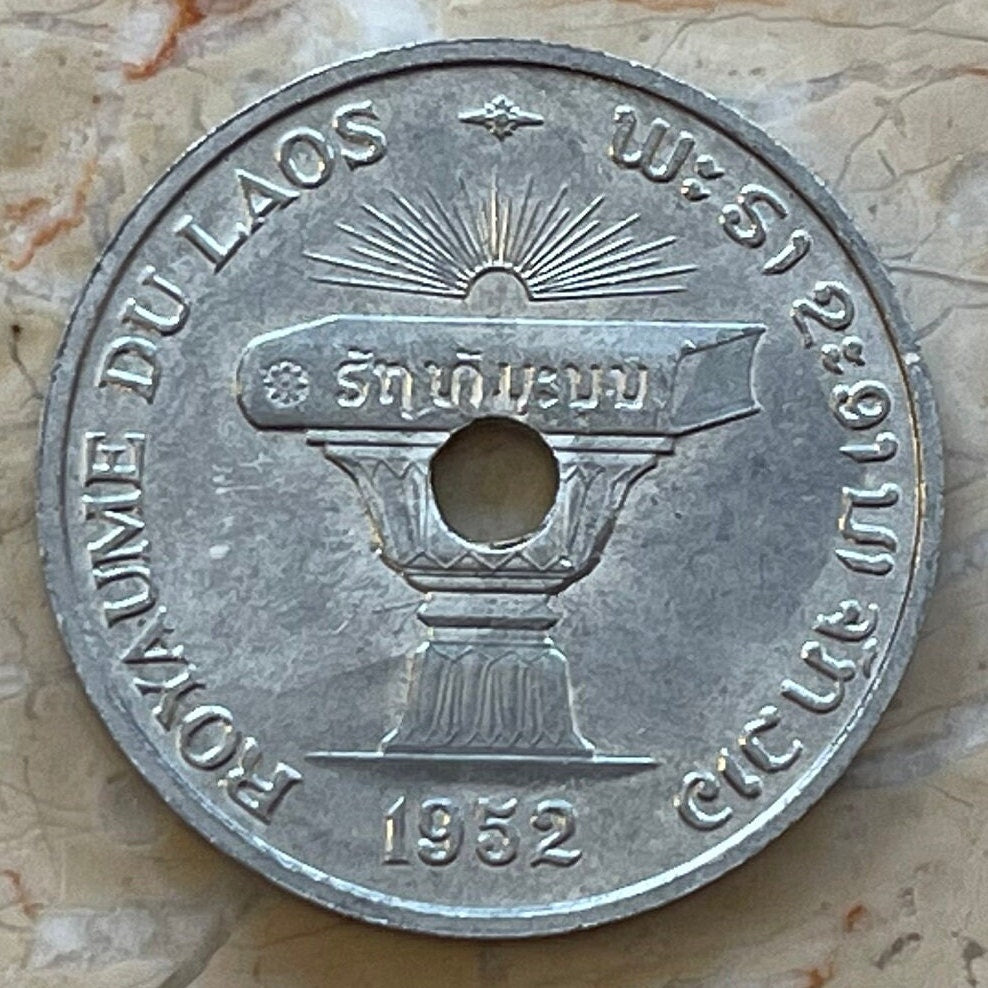elemintalshop
Constitution Book atop Buddhist Almsgiving Bowl 50 Cents Laos Authentic Coin Money for Jewelry (Hole) (Lotus) (Om Enlightenment Symbol) 1952
Constitution Book atop Buddhist Almsgiving Bowl 50 Cents Laos Authentic Coin Money for Jewelry (Hole) (Lotus) (Om Enlightenment Symbol) 1952
Couldn't load pickup availability
Constitution Book atop Buddhist "Kun" Almsgiving Chalice 50 Cents Laos Authentic Coin Money for Jewelry and Craft Making (Hole in Coin) (Kingdom of Laos) (Constitutional Monarchy) (1952)
Obverse: Constitution on top of chalice. Om enlightenment symbol radiating rays, above. Date below.
Lettering: ROYAUME DU LAOS ພະຣາຊະອານາຈັກລາວ
ຮັຖທັນະນູນ
1952
Translation: Kingdom of Laos
1952
Reverse: Lotus petals surrounding hole in coin.
Lettering: ໑໙໕໒
໕0 ງັດ
50 CENTS
1952
Translation: 1952 50 Cents
50 Cents 1952
Features
Issuer Laos
King Sisavang Vong (1946-1959)
Type Standard circulation coin
Year 1952
Value 50 Cents (0.5)
Currency Piastre (1952)
Composition Aluminium
Weight 3.84 g
Diameter 31 mm
Thickness 2.6 mm
Shape Round with a round hole
Orientation Coin alignment ↑↓
Demonetized Yes
Number N# 4586
References KM# 6, Schön# 3
WIkipedia:
Although duk baht, or giving alms is practiced all year round, Lao New Year seems to be an especially important date. Giving food to monks for their daily meal counts as an act of good deed, so doing this on New Year gets you an early start. Being prepared means waking up early to catch the monks, having enough food to pass around and carrying it all in your kun, or offering bowl. Made of aluminum, it comes in gold or silver, the bowl has a stand attached to it and looks sort of like a giant goblet. Often designed with intricate details, this traditional Lao cultural item is sized to store sticky rice, fruits, snacks or whatever your offerings may be. Depending on your local temple procedures, you’ll either wait with your filled kun for the monks to walk in single file carrying their alms bowls or you'll take your kun and walk over to their bowls, laid out on a table which gets replaced with a new, empty one every time it becomes full. When not in use for religious or cultural events the kuns can be stacked on top of each other in storage, but are usually on display in homes as they are quite beautiful on their own.
Source: https://www.laosinthehouse.com/blog//12-things-you-see-at-lao-new-year
**********
What is Alms Giving?
Almsgiving is the act of giving alms, or donations, in this case food, usually in the form of sticky rice. The act of giving alms in Laos is known as “Tak Bat” and is an ancient daily practice as part of Theravada Buddhism, pivotal to the cultural identity of most Lao people. The practice of giving alms in Luang Prabang has existed for over 600 years. This daily ritual involves devotees rising before dawn to cook sticky rice as a food offering to Buddhist monks. The main intention being twofold: lay persons provide daily food for the monks and the monks in return bestow merit.
Every morning at dawn, Buddhist monks and novices set out from their monastic temples to receive offerings of food from the local lay people. The offerings consist mainly of sticky rice, but sometimes may contain fruit or other sweet treats, forming the monks’ daily meal. With 34 active Buddhist monasteries in Luang Prabang, the long column of monks walking to receive their alms is certainly a sight to behold. The monks walk meditatively, silent and barefoot, throughout the town as they receive offerings of sticky rice from local people kneeling before them.
The Buddhist practice of almsgiving has a reciprocal relationship between those who give and receive alms. The monks are sustained by the offerings of food and in turn provide spiritual merit for the almsgivers. By giving food to sustain the monks, lay people gain merit, thereby generating “good” in their future lives. The alms giving ceremony occurs not only in Luang Prabang, but in villages and towns throughout Laos and other countries such as Cambodia, Myanmar, Sri Lanka and Thailand, to name a few. Tak bat occurs on the streets and also in temples during special Buddhist festival days.
Source: https://alifewithoutborders.org/alms-giving-luang-prabang/
**********
Wikipedia:
Om or Aum; ॐ, ओ३म्, IAST: Ōṃ , Tamil: ௐ, ஓம்) is the sound of a sacred spiritual symbol in Indian religions. It signifies the essence of the ultimate reality, consciousness or Atman. More broadly, it is a syllable that is chanted either independently or before a spiritual recitation in Hinduism, Buddhism, and Jainism. The meaning and connotations of Om vary between the diverse schools within and across the various traditions. It is also part of the iconography found in ancient and medieval era manuscripts, temples, monasteries and spiritual retreats in Hinduism, Buddhism, Jainism, and Sikhism.
********
Wikipedia:
In the Aṅguttara Nikāya, the Buddha compares himself to a lotus (in Pali, paduma), saying that the lotus flower raises from the muddy water unstained, as he raises from this world, free from the defilements taught in the specific sutta.
In Buddhist symbolism, the lotus represents purity of the body, speech and mind, as if floating above the murky waters of material attachment and physical desire. According to legend, Gautama Buddha's first steps made lotus flowers appear everywhere he stepped. In Tibet, Padmasambhava, the Lotus-Born, is considered the Second Buddha, having brought Buddhism to that country by conquering or converting local deities; he is normally depicted holding a flower. Lotus thrones are the normal pedestal for most important figures in Buddhist art.
*********
Wikipedia:
The Kingdom of Laos was a constitutional monarchy that served Laos beginning with its independence on 9 November 1953. The monarchy survived until December 1975, when its last king, Sisavang Vatthana, surrendered the throne to the Pathet Lao, who abolished the monarchy in favour of a Marxist–Leninist state called the Lao People's Democratic Republic, which has controlled Laos ever since.
Given self-rule with the new Constitution in 1947 as part of the French Union and a federation with the rest of French Indochina, the 1953 Franco-Lao Treaty finally established a sovereign, independent Laos, but did not stipulate who would rule the country. In the years that followed, three groups led by the so-called Three Princes, contended for power: the neutralists under Prince Souvanna Phouma, the right-wing party under Prince Boun Oum of Champassak, and the left-wing, North Vietnamese-backed Pathet Lao under Prince Souphanouvong and future Prime Minister Kaysone Phomvihane.
The Pathet Lao would eventually emerge victorious in the Laotian Civil War and establish the Lao People's Democratic Republic in 1975.
Share










Another terrific coin from this shop! Well packaged, great condition as usual.









